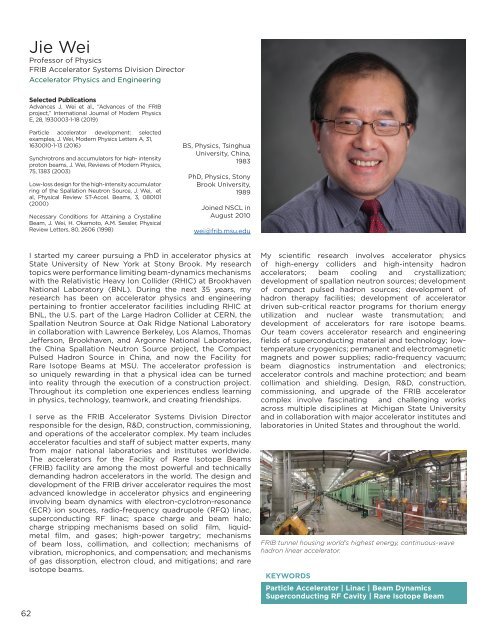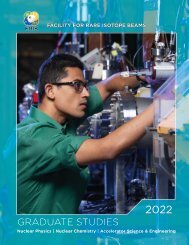2021FRIB/NSCL Graduate Brochure
Create successful ePaper yourself
Turn your PDF publications into a flip-book with our unique Google optimized e-Paper software.
Jie Wei<br />
Professor of Physics<br />
FRIB Accelerator Systems Division Director<br />
Accelerator Physics and Engineering<br />
Selected Publications<br />
Advances J. Wei et al., “Advances of the FRIB<br />
project,” International Journal of Modern Physics<br />
E, 28, 1930003-1-18 (2019)<br />
Particle accelerator development: selected<br />
examples, J. Wei, Modern Physics Letters A, 31,<br />
1630010-1-13 (2016)<br />
Synchrotrons and accumulators for high- intensity<br />
proton beams, J. Wei, Reviews of Modern Physics,<br />
75, 1383 (2003)<br />
Low-loss design for the high-intensity accumulator<br />
ring of the Spallation Neutron Source, J. Wei, et<br />
al, Physical Review ST-Accel. Beams, 3, 080101<br />
(2000)<br />
Necessary Conditions for Attaining a Crystalline<br />
Beam, J. Wei, H. Okamoto, A.M. Sessler, Physical<br />
Review Letters, 80, 2606 (1998)<br />
BS, Physics, Tsinghua<br />
University, China,<br />
1983<br />
PhD, Physics, Stony<br />
Brook University,<br />
1989<br />
Joined <strong>NSCL</strong> in<br />
August 2010<br />
wei@frib.msu.edu<br />
I started my career pursuing a PhD in accelerator physics at<br />
State University of New York at Stony Brook. My research<br />
topics were performance limiting beam-dynamics mechanisms<br />
with the Relativistic Heavy Ion Collider (RHIC) at Brookhaven<br />
National Laboratory (BNL). During the next 35 years, my<br />
research has been on accelerator physics and engineering<br />
pertaining to frontier accelerator facilities including RHIC at<br />
BNL, the U.S. part of the Large Hadron Collider at CERN, the<br />
Spallation Neutron Source at Oak Ridge National Laboratory<br />
in collaboration with Lawrence Berkeley, Los Alamos, Thomas<br />
Jefferson, Brookhaven, and Argonne National Laboratories,<br />
the China Spallation Neutron Source project, the Compact<br />
Pulsed Hadron Source in China, and now the Facility for<br />
Rare Isotope Beams at MSU. The accelerator profession is<br />
so uniquely rewarding in that a physical idea can be turned<br />
into reality through the execution of a construction project.<br />
Throughout its completion one experiences endless learning<br />
in physics, technology, teamwork, and creating friendships.<br />
I serve as the FRIB Accelerator Systems Division Director<br />
responsible for the design, R&D, construction, commissioning,<br />
and operations of the accelerator complex. My team includes<br />
accelerator faculties and staff of subject matter experts, many<br />
from major national laboratories and institutes worldwide.<br />
The accelerators for the Facility of Rare Isotope Beams<br />
(FRIB) facility are among the most powerful and technically<br />
demanding hadron accelerators in the world. The design and<br />
development of the FRIB driver accelerator requires the most<br />
advanced knowledge in accelerator physics and engineering<br />
involving beam dynamics with electron-cyclotron-resonance<br />
(ECR) ion sources, radio-frequency quadrupole (RFQ) linac,<br />
superconducting RF linac; space charge and beam halo;<br />
charge stripping mechanisms based on solid film, liquidmetal<br />
film, and gases; high-power targetry; mechanisms<br />
of beam loss, collimation, and collection; mechanisms of<br />
vibration, microphonics, and compensation; and mechanisms<br />
of gas dissorption, electron cloud, and mitigations; and rare<br />
isotope beams.<br />
My scientific research involves accelerator physics<br />
of high-energy colliders and high-intensity hadron<br />
accelerators; beam cooling and crystallization;<br />
development of spallation neutron sources; development<br />
of compact pulsed hadron sources; development of<br />
hadron therapy facilities; development of accelerator<br />
driven sub-critical reactor programs for thorium energy<br />
utilization and nuclear waste transmutation; and<br />
development of accelerators for rare isotope beams.<br />
Our team covers accelerator research and engineering<br />
fields of superconducting material and technology; lowtemperature<br />
cryogenics; permanent and electromagnetic<br />
magnets and power supplies; radio-frequency vacuum;<br />
beam diagnostics instrumentation and electronics;<br />
accelerator controls and machine protection; and beam<br />
collimation and shielding. Design, R&D, construction,<br />
commissioning, and upgrade of the FRIB accelerator<br />
complex involve fascinating and challenging works<br />
across multiple disciplines at Michigan State University<br />
and in collaboration with major accelerator institutes and<br />
laboratories in United States and throughout the world.<br />
FRIB tunnel housing world’s highest energy, continuous-wave<br />
hadron linear accelerator.<br />
KEYWORDS<br />
Particle Accelerator | Linac | Beam Dynamics<br />
Superconducting RF Cavity | Rare Isotope Beam<br />
62






